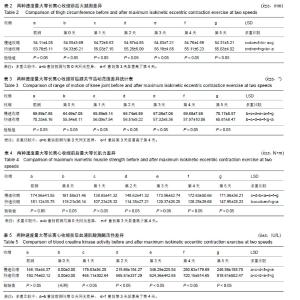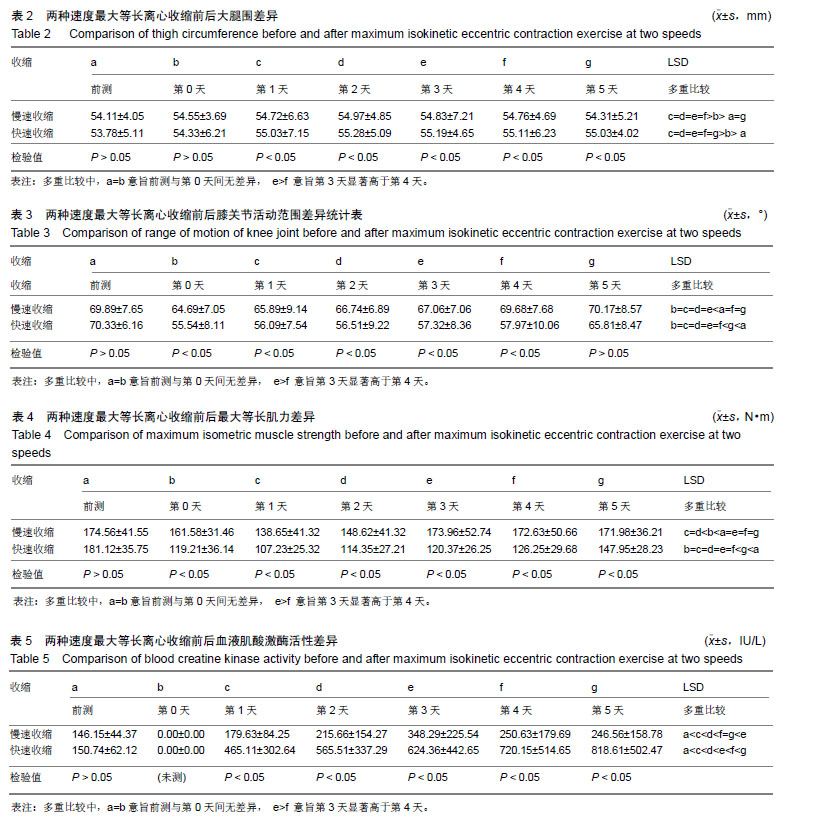| [1]Chen TC, Lin MJ, Lai JH, et al.Low-intensity elbow flexion eccentric contractions attenuate maximal eccentric exercise-induced muscle damage of the contralateral arm. J Sci Med Sport. 2018;21(10): 1068-1072.[2]Cheung K, Hume P, Maxwell L. Delayed onset muscle soreness: Treatment strategies and performance factors. Sports Med. 2003; 33(2):145-164.[3]Hedayatpour N, Izanloo Z, Falla D.Nosratollah Hedayatpour, Zahra Izanloo, Deborah Falla. The effect of eccentric exercise and delayed onset muscle soreness on the homologous muscle of the contralateral limb. J Electromyogr Kinesiol. 2018 ;41:154-159.[4]Dabbs NC, Black CD, Garner JC.Effects of whole body vibration on muscle contractile properties in exercise induced muscle damaged females. J Electromyogr Kinesiol. 2016;30:119-125.[5]Nasrabadi R, Izanloo Z, Sharifnezad A, et al.Muscle fiber conduction velocity of the vastus medilais and lateralis muscle after eccentric exercise induced-muscle damage. J Electromyogr Kinesiol. 2018;43:118-126.[6]Paddon-Jones D, Keech A, Lonergan A,et al.Differential expression of muscle damage in humans following acute fast and slow velocity eccentric exercise. J Sci Med Sport. 2005;8(3):255-263.[7]Azad M, Khaledi N, Hedayati M.Effect of acute and chronic eccentric exercise on FOXO1 mRNA expression as fiber type transition factor in rat skeletal muscles.Gene.2016;584(2):180-184.[8]Willems ME, Stauber WT. Force output during and following active stretches of rat plantar flexor muscles: Effect of velocity of ankle rotation. J Biomech. 2000;33(8):1035-1038.[9]Willems ME,Stauber WT. Force deficits by stretches of activated muscles with constant or increasing velocity. Med Sci Sports Exerc. 2002;34(4): 667-672.[10]von Werder SC, Disselhorst-Klug C.The role of biceps brachii and brachioradialis for the control of elbow flexion and extension movements. J Electromyogr Kinesiol. 2016;28:67-75.[11]Chapman D, Newton M, Sacco P, et al.Greater muscle damage induced by fast versus slow velocity eccentric exercise. Int J Sports Med. 2006; 27(8):591-598. [12]Sampson JA, Donohoe A, Groeller H. Effect of concentric and eccentric velocity during heavy-load non-ballistic elbow flexion resistance exercise. J Sci Med Sport. 2014;17(3):306-311.[13]Paddon-Jones D, Leveritt M, Lonergan A, et al.Adaptation to chronic eccentric exercise in humans: The influence of contraction velocity. Eur J Appl Physiol. 2001;85(5):466-471.[14]Butterfield TA, Herzog W.Effect of altering starting length and activation timing of muscle on fiber strain and muscle damage. J Appl Physiol (1985). 2006;100(5):1489-1498.[15]Haas C, Best TM, Wang Q, et al.In vivo passive mechanical properties of skeletal muscle improve with massage-like loading following eccentric exercise. J Biomech. 2012;45(15):2630-2636.[16]Chapman DW, Newton M, McGuigan M, et al. Effect of lengthening contraction velocity on muscle damage of the elbow flexors. Med Sci Sports Exerc. 2008;40(5):926-933. [17]Rockenfeller R, Günther M. Extracting low-velocity concentric and eccentric dynamic muscle properties from isometric contraction experiments. Math Biosci. 2016;278:77-93. [18]Nogueira FR, Libardi CA, Nosaka K, et al.Comparison in responses to maximal eccentric exercise between elbow flexors and knee extensors of older adults. J Sci Med Sport. 2014;17(1):91-95. [19]Chapman DW, Newton MJ, McGuigan MR, et al.Effect of slow- velocitylengthening contractions on muscle damage induced by fast-velocity lengthening contractions. J Strength Cond Res. 2011;25(1): 211-219.[20]Chen TC, Lin KY, Chen HL,et al.Comparison in eccentric-induced muscle damage among four limb muscles. Eur J Appl Physiol. 2011;111(2): 211-223. [21]Jamurtas AZ, Theocharis V, Tofas T, et al.Comparison between leg and arm eccentric exercises of the same relative intensity on indices of muscle damage. Eur J Appl Physiol. 2005;95(2-3):179-185. [22]Saka T, Akova B, Yazici Z, et al.Difference in the magnitude of muscle damage between elbow flexors and knee extensors eccentric exercises. J Sports Sci Med. 2009;8(1):107-115.[23]Chen TC.Variability in muscle damage after eccentric exercise and the repeated bout effect.Res Q Exerc Sport. 2006;77(3):362-371. [24]Bowers EJ, Morgan DL, Proske U. Damage to the human quadriceps muscle from eccentric exercise and the training effect. J Sports Sci. 2004;22(11-12):1005-1014.[25]Marek SM, Cramer JT, Fincher AL, et al. Acute Effects of Static and Proprioceptive Neuromuscular Facilitation Stretching on Muscle Strength and Power Output. J Athl Train. 2005;40(2):94-103.[26]John R.Jakeman,Roger G.Eston.Joint angle-torque characteristics of the knee extensors following eccentric exercise-induced muscle damage in young,active women.Journal of Exercise Science& Fitness.2013;11(1):50-56.[27]Chen TC, Nosaka K. Effects of number of eccentric muscle actions on first and second bouts of eccentric exercise of the elbow flexors. J Sci Med Sport. 2006;9(1-2):57-66. [28]Shepstone TN, Tang JE, Dallaire S, et al. Short-term high- vs. low-velocity isokinetic lengthening training results in greater hypertrophy of the elbow flexors in young men. J Appl Physiol (1985). 2005;98(5): 1768-1776.[29]陈忠庆,陈信良,钟承融,等.不同肌力测验方式对评估离心运动引起肌肉损伤反应的比较[J].大专体育学刊,2007,9(2):117-129.[30]Hunter AM, Galloway SD, Smith IJ, et al.Assessment of eccentric exercise-induced muscle damage of the elbow flexors by tensiomyography. J Electromyogr Kinesiol. 2012;22(3):334-341.[31]Franz A, Behringer M, Nosaka K,et al.Mechanisms underpinning protection against eccentric exercise-induced muscle damage by ischemic preconditioning. Med Hypotheses. 2017;98:21-27. |





